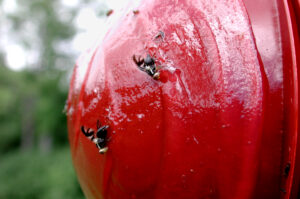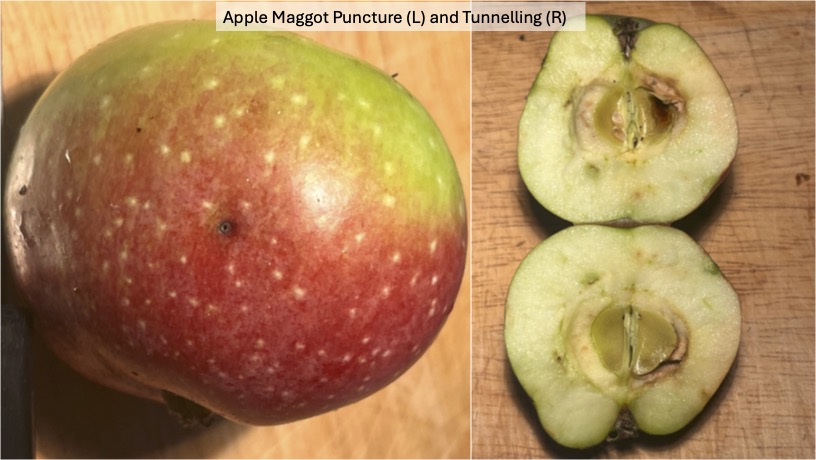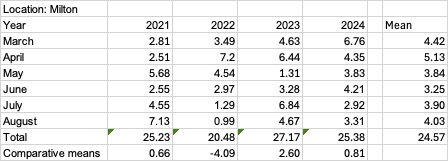Management: Apple Maggot & The Stink Bug Complex. August 16th, 2024


Apple Maggot on Baited Red Sticky Sphere
Introduction: Mid-August: Apple Maggot (Rhagoletis pomonella) (AM) is one of the most important economic insect pests of apples in New York. We are in the tail end of peak emergence in the Hudson Valley with strong emergence in organic and abandoned orchards. Since 2012, the Brown Marmorated Stink Bug (Halyomorpha halys – BMSB) has caused significant injury to late season pome and stone fruit from Mid-August through late harvest of Pink Lady.
Continued insect pest management should focus on Apple Maggot and the stink bug complex (Green, Brown and BMSB) being our greatest insect concerns this week. Obliquebanded Leafroller (OBLR) and Oriental Fruit Moth (OFM) adult trap numbers are again very low and trapping the pest complex should continue in commercial blocks .
We are finding low levels of AM emergence in baited red sticky spheres hung along the orchard perimeter. Thresholds have been exceeded in orchards with high endemic populations (ex. abandoned orchards or unsprayed orchards from frosted crop in 2023). These sites have likely had adequate soil moisture and high AM populations from infestations of fruit from 2023 depending on localized rain events. Trap captures of BMSB along woodland edge orchard perimeter have shown variable adult and nymph populations

Apple Maggot Infestation to Macoun 29th July, 2024.

Brief: As we moved through the week, most orchards have had ample rains with irrigation pond in good condition to abate tree stress over the next week. Relative to the 4-year regional means, we are presently experiencing a surplus in rain during the growing season in Milton, NY (March – August 31st (Only to 15th in 2024). Adequate soil moisture for apple maggot adults to emerge did not significantly increase presence of AM in commercial orchards this season, especially where AM Red Sphere traps are placed 30-100 meters from sites with historically high populations, ie near recently abandoned orchards (2-4 year abandonment with early and high seasonal populations).
That said, adult AM populations have shown less then 1 per trap per week in many scouted commercial Hudson Valley orchards this season. June and July and early August proved to be moderate to warm with a few days in the 90’s and apple maggot emergence in the mid-Hudson Valley beginning the week of June 23rd. In untreated / abandoned blocks, apple maggot infestations were noted in late July in Macoun. At this stage of AM adult preference, the later maturing varieties will be most susceptible as we continue harvest over the next few weeks.
The red spheres are very attractive to mature adult female AM flies, ready to oviposit. From work done by Chapman and Link, the apple maggot will first infest early apple varieties such as Early Gala,Ginger Gold and Sweetango, moving to later maturing varieties as the season progresses. Summer and early fall maturing varieties are particularly vulnerable, with thin skinned sweet and sub-acid varieties being most susceptible. These fruit should be protected upon trap threshold as they will be infested over the next two weeks if emergence continues throughout the region from recent rains.

The Stink Bug Complex: Both Green and Brown Marmorated Stink Bug tend to be more of a pest in orchards during periods of drought. With ample rainfall for woodland and weed seed production, providing moisture, carbohydrates and proteins, stink bugs will likely have less motivation to move into the orchard habitat to feed on pome fruit. That said, weather forecasts are calling for an additional 1.5″ of rain beginning Sunday through the 20th of August.
Tedders Trap. Adult numbers this week have increased to 17 / traps per week with nymphs across all instar stages at 12 / week in Orange County orchard sites.
Materials for management of the Apple Maggot and Brown Marmorated Stink Bug should be optimized given the overlap of efficacy. For example, the use of Leverage (Imidacloprid & β-Cyfluthrin) is labeled and effective for BMSB and AM, while Brigade 2EC (Bifenthrin) is labeled only for Stink Bug. Yet, pyrethroids, applied for BMSB management provides excellent control of apple maggot. Danitol (Fenpropathrin) is also very effective against BMSB, and when rotated with Brigade 2EC (requiring a 30d re-application interval) provides excellent management of AM.
A 0-DTH option for BMSB.Venerate XC from ProFarm (formally Marrone Bio Innovations), has a 0-day to harvest, having shown to have anti-feedent activity against BMSB in recent studies. Its use within the 7-day harvest would be an option if drought and stink bug become problematic near harvest and for fruit requiring very low MRL levels of pest management products.

Life Stages of the Invasive Brown Marmorated Stink Bug